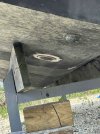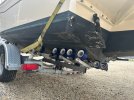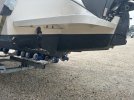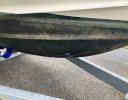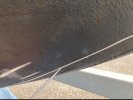Greetings folks. I just purchased a two year-old Grady white with Pettit HRT ablative bottom paint. The boat does not have an epoxy barrier coats, which I would like to apply in order to provide maximum protection. I have considered media blasting, but worried that that might be too aggressive for this project. However, I am not sure, so open to suggestions. What specific removal techniques/products would you suggest in my case?
You are using an out of date browser. It may not display this or other websites correctly.
You should upgrade or use an alternative browser.
You should upgrade or use an alternative browser.
Suggestions for removing new-ish ablative bottom paint?
- Thread starter Bruinjay
- Start date
Do you really want to go through the expense and hassle of stripping the old paint to barrier coat to repaint a 2 year old trailered boat? Its not a 30 year old Hatteras. There are many new boats that leave the dealer without a barrier coat and nothing bad happens. Repaint it, use the boat and don't worry about it.
Hookup1
GreatGrady Captain
- Joined
- Oct 16, 2007
- Messages
- 3,182
- Reaction score
- 907
- Points
- 113
- Age
- 70
- Location
- Cape May, NJ
- Model
- Islander
Rotary power wash and apply another coat of same paint. I use Pettit Hydrocoat. 1
I repaint the complete bottom every 2 years. Every year I do a “Carolina Smile” - waterline, bow and sides. Leave bottom alone.
Bottom definitely should be blasted and painted. Probably best to have Marina pull off trailer, power wash and block high. Easier to paint.
I repaint the complete bottom every 2 years. Every year I do a “Carolina Smile” - waterline, bow and sides. Leave bottom alone.
Bottom definitely should be blasted and painted. Probably best to have Marina pull off trailer, power wash and block high. Easier to paint.
I really don’t, but worry about water intrusion when the boat is slipped…based on the images, you think I can safely run it? How long would you expect she can sit wet without risk?Do you really want to go through the expense and hassle of stripping the old paint to barrier coat to repaint a 2 year old trailered boat? Its not a 30 year old Hatteras. There are many new boats that leave the dealer without a barrier coat and nothing bad happens. Repaint it, use the boat and don't worry about it.
Hookup1
GreatGrady Captain
- Joined
- Oct 16, 2007
- Messages
- 3,182
- Reaction score
- 907
- Points
- 113
- Age
- 70
- Location
- Cape May, NJ
- Model
- Islander
Where are you? How long is the boat in the water through the year?I really don’t, but worry about water intrusion when the boat is slipped…based on the images, you think I can safely run it? How long would you expect she can sit wet without risk?
"New" gelcoat is more resistant to water absorption. Dealers typically don't Interprotect before painting. GW seems to have avoided the problem that other manufacturers (Ocean Yachts, Post, others) had with gelcoat popping.
If you do soda blast you will need to Interprotect (3 or 4 coats) and bottom paint (2 coats).
That bottom was cleaned on the trailer. Get it off, power wash and paint.
If you are going to part any of the already areas painted with ablative, you have to use ablative. So painting barrier coat will require the removal all all ablative.
Options for that include sanding and blasting ( but nor sand blasting.) Although I might recommend a barrier coat over a new unpainted hull or a pretty bad condition hull I am less inclined to apply it over a painted hull unless very well prepared and that is where the risk lies. I can't tell how deep the scratches are near the forward keel but those need to be looked at.
You hull looks typical for a wet slipped hull. The lighter color areas should be sanded or scrubbed. Scrub a test spot with a heavy duty scouring pad like a scotch brite and see how it cleans up. If it does clean up you probably will not have to sand,
It's time to sand or media blast when the paint builds up over time and or cracks or flakes off.
I have been using Hydrocoar on my boats for many years. There are properties I like and some I don't. Contrary to the belief that ablative can complete wear off. I have found that over the years the layers build up and can get fairly thick.
Hydrocoat is not that easy to completely remove. It works well and can last two seasons with minor touch up off season. It should be applies in thin coats or it will seriously build up thickness.
Historically, Grady hulls have not been plagued with blisters and that is what you are trying to avoid with the barrier coat.
The last time (pre covid) I priced out sanding, barrier coating and 2 coats of bottom antifouling the cost was $100 a foot and that was with using the marinas paint selection.
Options for that include sanding and blasting ( but nor sand blasting.) Although I might recommend a barrier coat over a new unpainted hull or a pretty bad condition hull I am less inclined to apply it over a painted hull unless very well prepared and that is where the risk lies. I can't tell how deep the scratches are near the forward keel but those need to be looked at.
You hull looks typical for a wet slipped hull. The lighter color areas should be sanded or scrubbed. Scrub a test spot with a heavy duty scouring pad like a scotch brite and see how it cleans up. If it does clean up you probably will not have to sand,
It's time to sand or media blast when the paint builds up over time and or cracks or flakes off.
I have been using Hydrocoar on my boats for many years. There are properties I like and some I don't. Contrary to the belief that ablative can complete wear off. I have found that over the years the layers build up and can get fairly thick.
Hydrocoat is not that easy to completely remove. It works well and can last two seasons with minor touch up off season. It should be applies in thin coats or it will seriously build up thickness.
Historically, Grady hulls have not been plagued with blisters and that is what you are trying to avoid with the barrier coat.
The last time (pre covid) I priced out sanding, barrier coating and 2 coats of bottom antifouling the cost was $100 a foot and that was with using the marinas paint selection.
I am located in Southern California. So plan to run it 365. She’ll be slipped rest of summer for sure. Thanks all for the tips! I’ll try to remove the ablative stuff myself then take it someplace for epoxy barrier coat + fresh ablative paint
Halfhitch
GreatGrady Captain
If you are insistent on removing the anti-foul paint to the point a barrier coat can successfully be applied, I predict that when you are finished and are looking back, you will regret not hiring it out. Having said that, I wish you Gods speed. Take pictures and give us a blow-by-blow account.
I love that last comment! I am a big believer in hiring professionals to do good work. I might end up doing that after all. My plan is to start with anti-fouling stripper in a small area to see just how tough this is to get off and take it from there. I just know few people if any, would put as much care and detail into a job like this as I would.
Halfhitch
GreatGrady Captain
No, No, No....if you are going to use a high pressure air media blaster, you must use a gentle media like soda, so it won't abrade the gelcoat so fast. Especially if you are inexperienced. You need to learn the correct air pressure, the correct angle of attack and distance for the nozzle and experimement with the type of media. If you are not equipped properly for clean-up, you will make a mess not often seen and surely not something you would want around your house. Ablative paint is nasty stuff.Any thoughts on utilizing a dustless media blaster, versus chemical stripper plus sandpaper? I located on mobile media blaster that uses crushed glass at low psi…
Hookup1
GreatGrady Captain
- Joined
- Oct 16, 2007
- Messages
- 3,182
- Reaction score
- 907
- Points
- 113
- Age
- 70
- Location
- Cape May, NJ
- Model
- Islander
The reply’s are right - the hard work part is striping and prepping the bottom. And if it’s not properly prepped you should not barrier coat and paint.
My advice would be to power wash, sand, do minor repairs, barrier cost the repairs and bottom paint. See how it goes for a few years. Then decide.
If/when you strip bottom have it soda blasted or some other media (not sand!). Find the right guy to do it with references. The better ones won’t even break the gelcoat shine! Someone who does a lot of them start to finish. If you were closer to CM I would send you to my guy.
My advice would be to power wash, sand, do minor repairs, barrier cost the repairs and bottom paint. See how it goes for a few years. Then decide.
If/when you strip bottom have it soda blasted or some other media (not sand!). Find the right guy to do it with references. The better ones won’t even break the gelcoat shine! Someone who does a lot of them start to finish. If you were closer to CM I would send you to my guy.
Last edited:
Coastboater
GreatGrady Captain
- Joined
- Jun 9, 2023
- Messages
- 212
- Reaction score
- 73
- Points
- 28
I had bottom paint removed on a 25’ EdgeWater a few years ago. They used 150 grit orbital sanders, followed by 3 coats of barrier.
Pro tip - protect the interior of the boat from the dust.
Pro tip - protect the interior of the boat from the dust.
Sibs
Well-Known Member
- Joined
- Sep 11, 2019
- Messages
- 62
- Reaction score
- 20
- Points
- 8
- Age
- 58
- Location
- Falmouth MA
- Model
- Express 330
I just had mine done with the dustless blast system, it is very fine glass with water, it worked excellent and left the finish with just enough texture that doesnt require sanding. I applied 4 Coats of interprotect 2000e then 2 coats of Pettit vivid white semi albative. Worked out well. Love the white bottom.
DennisG01
GreatGrady Captain
- Joined
- Sep 1, 2013
- Messages
- 7,428
- Reaction score
- 1,412
- Points
- 113
- Location
- Allentown, PA & Friendship, ME
- Model
- Offshore
Chiming in about what was said above to save you time and money and time... and time 
Don't worry about the barrier coat. That's for older generations of gelcoat that weren't as impervious to water penetration as the newer, higher quality gelcoat formulations used by some higher end manufacturers. Sea Ray's, for example, don't need it (I have more experience with them) - Grady's are fine without it, too.
But...if you're insisting on doing it... find a local sodablaster company and write a check.
Don't worry about the barrier coat. That's for older generations of gelcoat that weren't as impervious to water penetration as the newer, higher quality gelcoat formulations used by some higher end manufacturers. Sea Ray's, for example, don't need it (I have more experience with them) - Grady's are fine without it, too.
But...if you're insisting on doing it... find a local sodablaster company and write a check.


